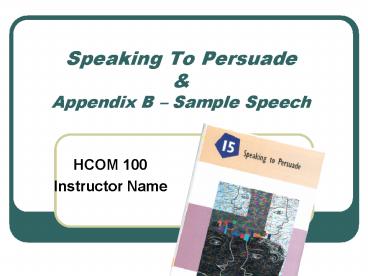Speaking To Persuade - PowerPoint PPT Presentation
1 / 19
Title:
Speaking To Persuade
Description:
How to Adjust Ideas to People and People to Ideas. Persuasion Defined ... Refer to universal beliefs and concerns. Show how the topic affects them. Be realistic ... – PowerPoint PPT presentation
Number of Views:833
Avg rating:3.0/5.0
Title: Speaking To Persuade
1
Speaking To PersuadeAppendix B Sample Speech
- HCOM 100
- Instructor Name
2
PREVIEWSpeaking to Persuade
- Persuasion Defined
- Motivating Your Audience
- Selecting and Narrowing Your Persuasive
Presentation Topic - Organizing Your Persuasive Messages
- Strategies for Persuading Your Audience
- How to Adjust Ideas to People and People to Ideas
3
Persuasion Defined
- Persuasion is the process of attempting to change
or reinforce attitudes, beliefs, values, or
behavior. - The persuasive speaker invites listener to make a
choice, rather than just offering information
about the options. - The persuasive speaker asks the audience to
respond thoughtfully to the information
presented. - The persuasive speaker intentionally tries to
change or reinforce the listeners feelings,
ideas, or behavior.
4
Motivating Your Audience
- Motivating with dissonance
- Cognitive dissonance occurs when you are
presented with information that is inconsistent
with your current thinking or feelings. - Motivating with needs
- Maslows Hierarchy
- Physiological
- Safety
- Social
- Self esteem
- Self-actualization
5
Motivating Your Audience
- Motivating with Fear Appeals
- Threat to family members
- Credibility of speaker
- Perceived realness of the threat
- Motivating with Positive Appeals
- Promising that good things will happen if the
speakers advice is followed.
6
Selecting and Narrowing Your Persuasive Topic
- Who is the Audience?
- What is the Occasion?
- What are my interests and experiences?
- Brainstorming
- Scanning Web Directories and Web Pages
- Listening and Reading for Topic Ideas
7
Identifying YourPersuasive Purpose
- General Purpose
- Persuade
- Specific Purpose
- Attitude (learned predisposition to respond
favorably or unfavorably) - Belief (sense of what is true or false)
- Values (enduring conception of right and wrong)
8
Developing Your Central Idea as a Persuasive
Proposition
- A proposition is a statement with which the
speaker wants their audience to agree. - Proposition of Fact
- True/False
- Proposition of Value
- Judge worth or importance of something
- Proposition of Policy
- Advocates specific action, includes should
9
Strategies forPersuading Your Audience
- Ethos Establishing Your Credibility
- An audiences perception of the speakers
competence, trustworthiness, dynamism - Charisma
- Initial, derived, terminal
10
Strategies forPersuading Your Audience
- Logos Using Evidence and Reasoning
- Proof consists of both evidence and the
conclusions you draw (reasoning) - Inductive reasoning
- Arrives at a general conclusion from specific
instances - Reasoning by analogy
- Deductive reasoning
- Reasoning from a general statement to reach a
specific conclusion - Causal reasoning
- Relate two or more events in such a way as to
conclude that one or more of the events caused
the others
11
Logical Fallacies
- Causal Fallacy
- Bandwagon Fallacy
- Either-Or Fallacy
- Hasty Generalization
- Personal Attack
- Red Herring
- Appeal to Misplaced Authority
- Non Sequitur
12
Strategies forPersuading Your Audience
- Pathos Using Emotion
- Emotion-arousing verbal messages
- Concrete illustrations and descriptions
- Nonverbal messages
13
Organizing YourPersuasive Messages
- Problem and Solution
- Cause and Effect
- Refutation
- An organizational strategy by which you identify
objections to your proposition and refute them
with arguments and evidence
14
Organizing YourPersuasive Messages
- Monroes Motivated Sequence
- Attention
- Need
- Satisfaction
- Visualization (positive and negative)
- action
15
How to Adapt Ideas to Peopleand People to Ideas
- The Receptive Audience
- Identify with your audience
- Be overt in stating your speaking objective
- Use emotional appeal
- The Neutral Audience
- hook them with introduction
- Refer to universal beliefs and concerns
- Show how the topic affects them
- Be realistic
16
How to Adjust Ideas to Peopleand People to Ideas
- The Unreceptive Audience
- Dont immediately announce your persuasive
purpose - Advance your strongest arguments first
- Acknowledge opposing points of view
- Be realistic
17
Appendix B Sample Speech
- Persuasive Example
- Prosecutorial Abuse
18
Prosecutorial AbuseExample Persuasive Speech
- Intro
- Attention Getter
- Propositional Statement
- Preview of all main points
- Transition
- Body
- Need/Problem
- Point One
- Evidence
- Transition
- Point Two
- Evidence
- Transition
- Point Three
- Evidence
- Transition
- Conclusion
- Restate Proposition
- Call to action
- Review of main points
- Restate Attention-getter
19
What questions do you have?
- Homework
- 1.) Reading?
- 2.) Turn in assignments?































